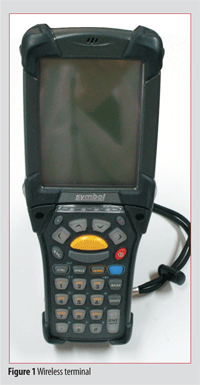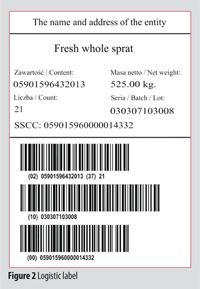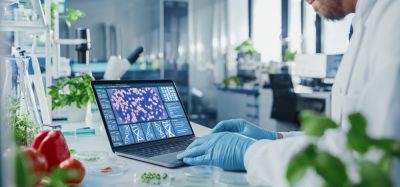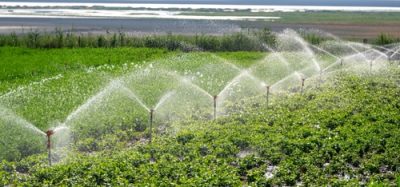The implementation of an Advanced Traceability System in a Polish fish processing plant
Posted: 22 February 2010 | Olga Szulecka, Sea Fisheries Institute, Gdynia | No comments yet
At present, food safety is one of the main priorities among European Union policies. The very significant element of food safety is traceability, i.e. “the ability to trace and follow a food, feed, food-producing animal or substance intended to be, or expected to be incorporated into a food or feed, through all stages of production, processing and distribution1.”
Article 18 of the main EU legal act in the field of food and feed safety – Regulation (EC) No 178/2002 of the European Parliament and of the Council – requires that “the traceability of food, feed, food-producing animals, and any other substance intended to be, or expected to be, incorporated into a food or feed shall be established at all stages of production, processing and distribution1.”
At present, food safety is one of the main priorities among European Union policies. The very significant element of food safety is traceability, i.e. "the ability to trace and follow a food, feed, food-producing animal or substance intended to be, or expected to be incorporated into a food or feed, through all stages of production, processing and distribution1." Article 18 of the main EU legal act in the field of food and feed safety - Regulation (EC) No 178/2002 of the European Parliament and of the Council - requires that "the traceability of food, feed, food-producing animals, and any other substance intended to be, or expected to be, incorporated into a food or feed shall be established at all stages of production, processing and distribution1."
At present, food safety is one of the main priorities among European Union policies. The very significant element of food safety is traceability, i.e. “the ability to trace and follow a food, feed, food-producing animal or substance intended to be, or expected to be incorporated into a food or feed, through all stages of production, processing and distribution1.”
Article 18 of the main EU legal act in the field of food and feed safety – Regulation (EC) No 178/2002 of the European Parliament and of the Council – requires that “the traceability of food, feed, food-producing animals, and any other substance intended to be, or expected to be, incorporated into a food or feed shall be established at all stages of production, processing and distribution1.”
The same article also lays down a requirement by which “food and feed business operators shall be able to identify any person from whom they have been supplied with a food, a feed, a food-producing animal, or any substance intended to be, or expected to be, incorporated into a food or feed, and shall have in place systems and procedures to identify the other businesses to which their products have been supplied. This information shall be made available to the competent authorities on demand1.”
The aforementioned article 18 points out that it is mandatory to implement external traceability systems, not the internal ones. However, without the implemented internal traceability systems it is very difficult to track down the cause of the detected risk and to quickly and effectively recall from the market exclusively those batches of products that pose a risk to the consumers.
The scientists stressed that “a truly functional traceability system includes both internal and external traceability2.”
Therefore, the food industry operators and processing plants in particular implemented internal traceability systems, which make it possible to trace batches of raw materials and products inside the operators.
At present, the frequently applied solution within the Polish fish industry as regards to traceability systems is based on data from paper documents only. It is a relatively inexpensive approach, however it is not always effective, particularly in the case of large entities or those that conduct production processes encompassing the rich product assortment. Then the paper documents do not always allow for fast information retrieval, which is especially significant when a recall from the market of the risk-causing product batch becomes necessary.
“The use of computer, however, enables a larger amount of data to be handled and thereby it becomes realistic to develop traceability systems with very detailed information about both the product and its processing history3.”
In the presented project, a computerised system for internal traceability based on the GS1 standards for the data exchange was implemented and tested in the fish processing plant.
Stages of internal traceability system implementation
The implementation stages of the traceability system in the fish processing plant, realised within the framework of the project titled ‘Implementation of fish raw materials and products traceability system’ and co-financed from the Sectoral Operational Programme ‘Fishery and fish processing 2004-2006,’ are presented below.
Analysis of the conducted production processes
The first implementation stage of the IT-based internal traceability system was the analysis of all processes and operations as regards processing, storage and logistics in a given entity, starting from raw material reception, ensuing through all stages of production and storage and ending at product completion and its delivery to the recipient.
First of all, the number and complexity of the conducted operations was assessed during the analysis. Particular attention was paid to those production operations during which different batches have been joined or split into smaller sub-batches because this mode of processing requires a specific annotation in the production batch number.
The conclusions obtained from the analysis of the production and storage processes allowed the needs for the number of equipment units and the software functionality to be defined.
Applied software
The next implementation stage of the IT-based traceability system consisted of the description and flow chart elaboration for all operations conducted in the processing plant. The aim of this stage was to facilitate the creation of a computerised database for the traceability system data.
The adaptation of the IT system to the specific production in the processing plant and to GS1 requirements with regard to codes of localisation (localisations of production and storage operations), batches of raw materials and products, production shifts, types of products and packagings, and raw material suppliers and product recipients was a significant aspect of the implementation process.
The application of GS1 standards and the computerised on-line database, based on MS SQL Server, allowed for the preparation of software fulfilling the requirements necessary to trace batches of raw materials and products in the supply chain. At the same time, the software constituted a solution that has brought advantages in the form of more efficient management of production and storage processes in the plant.
The implementation of the described IT solution allowed fast input, archiving and retrieval of information as well as generating different types of reports that have made it easier to manage the production processes and stored products in a warehouse.
Equipment used
Due to the specificity of environmental conditions in the fish processing plant, i.e. low temperature and high air humidity, the industrial equipment such as thermotransfer barcode printers, wireless terminals, access points, database server and panel computers were used to collect and store data in the traceability system. The panel computers allowed data input via a computer monitor without using a separate keyboard. The above-mentioned equipment, except wireless terminals and database server, was housed in protective boxes in order to protect it from damage and an accidental water spill.
Most of the equipment was connected with wires, although in order to effectively use mobile devices such as wireless terminals, radio transmission was applied to transmit data to access points of the network system. This allowed all production halls to be included within the system range and therefore permitted easy input and retrieval of data by the employees as well as on-line access to the data.
Training of employees and system operation
Employee training in the field of system functioning was a very significant stage in the implementation of the IT-based traceability system. The system supervision as well as database updating for new raw materials, products, suppliers and recipients has been assigned to the personnel from the management group. However, the basic system operation has been assigned to the chosen production workers who enter data about the conducted production and storage operations, and print GS1-128 labels that are affixed to the pallets of fish raw materials, semi-products and products.
Such production workers were responsible for the practical implementation of the traceability system. Therefore, the most intensive training effort was aimed at that particular group of employees.
The implemented system registered all the performed operations including the time and person who has conducted a given function. Therefore, each employee had to log into the system using the log in and password before starting to work on the system equipment. This procedure allowed not only the assess-ment of the operation duration but also the identification of a person performing the given function. That is particularly significant in the case of erroneous data entries.
The presented traceability system that has been implemented in the fish processing plant encompassed the whole production and storage process, starting from the reception of raw material, its processing (gutting, filleting, freezing, thawing and pre-smoking) and ending at the product issue as the final stage of the production process. The system allowed tracing of all batches of raw materials and products in the production and storage chain.
Reports generated by the system contained all data related to the processing, storage and distribution operations and facilitated the whole production process management.
Application of the GS1 standards
GS1 and Application Identifiers according to the GS1 standards
GS1 “was formed from the joining together of EAN International and UCC, the Uniform Code Council, and is today the most widely used supply chain standards system in the world4.”
The GS1 standards consist of sets of requirements which define the rules of international data exchange during trade operations in the food industry as well as in other sectors. Thanks to the global application, these standards can also be used in traceability systems where they secure the fast retrieval of essential information about the traced product batch or dispatched goods.
Flexibility of the GS1 standards allows for their use in the fish industry too. By apply- ing the requirements of the standards, the specific batches of raw materials, products and packagings can be traced along the supply chain.
The GS1 standards are based on the international codified system for numbering the information on the transferred product. According to the GS1 standards, in the case of data exchange the most significant identifiers, so-called Application Identifiers (AI)4 are as follows:
» GTIN – 14 digits – Global Trade Item Number which defines a given product and its amount, e.g. a box containing the constant net weight of fish
» GLN – 13 digits – Global Location Number which denotes a given entity or its specific department, e.g. warehouse
» SSCC5 – 18 digits – Serial Shipping Container Code that allows the unique on a global scale identification of a pallet or other logistics unit
The above-mentioned Application Identifiers were used in the presented internal traceability system. However, in order to secure the transfer of other essential information about the specific product batches, additional AIs were also used, as listed below:
» AI 10 – Batch/lot. This identifier may have from one to 20 numeric signs. At different stages of the traceability system from eight to 12 digits were used (in the DDMMYY format and as additional digits coding, e.g. production shift)
» AI 31nn – Net weight. This identifier was used for marking the mass of specific pallets in the AI 3103 format which denotes net weight in kilograms to three decimal places
» AI 37 – Count. AI 37 was used to mark the number of boxes on the pallet
» AI 90-99 – Internal information. Those application identifiers were used for coding numbers attributed to specific localisations of the production process as well as the system users, i.e. the employees of the processing plant
The above-mentioned AIs allowed the registration and transfer of data necessary for the identification of specific product batches and pallets in the entire production process.
GS1 logistic label
In the GS1 system, the logistic labels with a GS1-128 bar code are used in order to share the product information during its transfer between the operations or entities. The labels contain the necessary Application Identifiers coded in a human-readable format as well as GS1-128 bar code.
In the implemented traceability system, the logistic labels with GS1-128 bar codes were assigned to all the pallets with raw materials, semi-products and final products during the whole production process (from the reception to the final distribution). This allowed the identification of any particular product by listing on the logistic label the following information: name of the product, item number – GTIN (Global Trade Item Number), batch number, pallet number – SSCC (Serial Shipping Container Code) and additional data such as, the number of boxes on the pallet and net weight of a pallet6.
All the used data structures were compatible with the GS1 standards, which has facilitated data transfer between the operators in the international trade.
Traceability system verification
The verification of traceability systems is necessary to ensure the system efficiency. Then, in the case of recall procedure execution, food operators can be sure that the particular product batch will be quickly and efficiently withdrawn from the supply chain. Therefore, testing of the traceability system has become a key element of the implementation procedure. The first test dealt with the IT system performance, i.e. proper functioning of all the equipment, correct data transfer among the electronic devices and the information registered into and retrieved from the database. The conducted test has confirmed the proper functioning of the system.
However, because of the issues regarding food safety, testing the system performance to trace raw materials and product batches in the production and storage chain was also very important.
In the presented processing plant, the tracing of randomly selected 40 raw material batches and 50 product batches was performed. The raw material batches were traced in the database throughout the particular operations to the distributed product batches, while the product batches were traced back to the received raw material batches. For all the analysed cases, information was obtained in less than three minutes.
In the case of raw material, there were five batches that contained erroneous information, and that amounted to 12.5 per cent of all the analysed batches. In the case of product, four batches had errors in the presented information that amounted to eight per cent of all the analysed batches. It is significant that in all cases, the errors were singular and caused by humans, i.e. they resulted from improper data entry or the lack of data entry, but not from the improper functioning of the IT system.
It should also be underlined that the above mentioned tests were conducted during the early stage of system functioning when the employees were still being trained how to use the system.
Conclusions
The implementation of the traceability system in the fish processing plant was a multistage process because it required the analysis of the existing processes and choosing the proper software and IT equipment as well as the installation of the equipment and software, personnel training and testing of the system.
The cooperation among the scientists from the Sea Fisheries Institute in Gdynia, the employees of the IT-company, personnel of the fish processing plant and the employees of GS1 Poland was essential during the system implementation.
The implemented system allowed for collection, in a database, of the information necessary to identify batches of raw materials, semi-products and products at specific stages of the production process. This makes the tracing of such batches fully feasible.
However, “today, the point is not only to trace the products efficiently but also to decrease recalls and the number of batches constituting a given finished product7.”
Therefore, the fast information retrieval from the database facilitates the analysis of the occurring risk, and allows for quick tracking down of the batches of products that create such risk.
Moreover, thanks to the applied software it was possible to decrease the number of the used paper documents as the information about, for example, goods stored in warehouses was generated directly in the database; the information was also retrieved from it.
The implemented system also allows the fulfilment of legal requirements in connection to the confirmation of fish raw material origin8. Thanks to the fast retrieval from the database of the document dealing with the raw fish delivery, it is possible to correlate such data with the final product and therefore confirm its origin.
The verification of the implemented traceability system in the above mentioned processing plant has confirmed that almost all the raw material and final product batches can be traced efficiently. Moreover, all information about the particular product batch was obtained in less than three minutes.
Because of the positive results obtained during testing of the described traceability system it would be worth implementing and testing such a system in a plant that produces more processed fish products, e.g. canned or marinated fish products.




References
- Anon. 2002. Regulation (EC) No 178/2002 of the European Parliament and of the Council of 28 January 2002 laying down the general principles and requirements of food law, establishing the European Food Safety Authority and laying down procedures in matters of food safety (Official Journal L 31, 1.2.2002, p. 1-24 with later amendments).
- Randrup, M., Storøy, J., Lievonen, S., Margeirsson, S., Árnason, S. V, Ólavsstovu, D., Frosch Møller, S., & Frederiksen, M.T. 2008. Simulated recalls of fish products in five Nordic countries. Food Control 19: 1064-1069.
- Moe, T. 1998. Perspectives on traceability in food manufacture. Trends in Food Science & Technology 9: 211-214.
- GS1. 2007. The GS1 traceability standard: What you need to know. GS1 Global Office. Brussels, Belgium, Available at: http://www.gs1.org/docs/traceability/GS1_ tracebility_what_you_need_to_know.pdf. Accessed October 9, 2009.
- Furnes, A., & Osman, K. S. 2003. Developing traceability systems across the supply chain. In Food authenticity and traceability, pp. 473-495. red. M. Lees., Cambridge, England: Woodhead Publishing Limited and CRC Press LLC.
- EAN.UCC. 2002. Traceability of Fish Guidelines. Available at: http://www.gs1ca.org/files/std_traceabilityoffish_v1_en.pdf. Accessed October 9, 2009.
- Dupuy, C., Botta-Genoulaz, V., & Guinet, A. 2005. Batch dispersion model to optimise traceability in food industry. Journal of Food Engineering 70: 333-339.
- Anon. 2001. Commission Regulation (EC) No 2065/2001 of 22 October 2001 laying down detailed rules for the application of Council Regulation (EC) No 104/2000 as regards informing consumers about fishery and aquaculture products (Official Journal L 278, 23.10.2001, p. 6-8 with later amendments).









